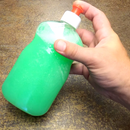Introduction: Penrose Triangle
The Penrose triangle, also known as the Penrose tribar or the impossible tribar, is a triangular impossible object, an optical illusion consisting of an object which can be depicted in a perspective drawing, but cannot exist as a solid object. It was first created by the Swedish artist Oscar Reutersvärd in 1934. Independently from Reutersvärd, the triangle was devised and popularized in the 1950s by psychiatrist Lionel Penrose and his son, prominent Nobel Prize-winning mathematician Sir Roger Penrose, who described it as "impossibility in its purest form". It is featured prominently in the works of artist M. C. Escher, whose earlier depictions of impossible objects partly inspired it.
Although it is actually impossible to make the triangle as a solid object, you can get pretty close with your 3D printer. Of course it remains an optical illusion, but I still find it fascinating to look at it.
Video tutorial (Includes 3d print timelaps)
Step 1: Design
Drawing the object to print is the most work. Yet it only took me half an hour to do this. First I calculated an L shape with the same length on both sides. Then I drew an axis up on one of the corners. Then I rotated the image until I found the triangle shape. I then connected the axis up to the other end of the L shape. Finally I drew a protrusion on the axis upwards that falls exactly in front of the inside of the L shape. When the drawing is almost finished it becomes quite difficult to see it properly. Then you see a 3d object, then an impossible triangle and so on ...
I have added the drawing and the STL file in the attachments.
Step 2: Print
When printing, I chose to use a raft as a base. My print bed has been through a few things and has some uneven units. If you have a straight print bed, you can also do without raft.
I chose to use supports because I was not sure if it was necessary. In retrospect, I think the print would have been successful without supports.
Furthermore, I have used the prescribed settings for the printer with 20% fill in in a triangle shape.
The video shows a time-lapse of the print.
Step 3: Finishing
After printing I finished the print. To start with the raft taken off and the remains removed with a knife. The support broke off and the large remains also removed with a knife.
Finally, I finished the object with a piece of P240 sandpaper. Especially the tip of the protrusion must be finished completely straight.
To give it an even tighter finish, you can put it under a bucket with a bowl of acetone for a while. The plastic reacts to this, making the outer layer completely flat. Heating is also possible, but I am not a fan of this myself. The plastic is very fragile and if you touch it in a warm state, there is immediate damage.
Step 4: Ready!
Ready! Now keep the tip of the protrusion exactly in the corner of the L shape ... I can keep looking at it!
Video tutorial















